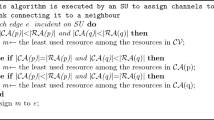Abstract
In this paper, considering a cognitive radio (CR) network, we propose a hard combining cooperative sensing scheme that embeds a solution of finding optimal number of users who can participate in user cooperation. The solution to our scheme includes two cases, one when single antenna is used at the CR receiver, and the other, when multiple antennas are employed. Moreover, we have derived the closed-form expression for Bayes risk, which is a measure of probability of error. Bayes risk constitutes false alarm and missed detection probabilities. We have found optimum number of users, who can participate in the fusion scheme, by minimising the probability of error. Our simulation results show the improvement in receiver operating characteristics curve, when optimum number of users are allowed to participate in the fusion scheme.





Similar content being viewed by others
References
D. Cabric, A. Tkachenko, R.W. Brodersen, Experimental study of spectrum sensing based on energy detection and network cooperation, in Proceedings of the First International Workshop on Technology and Policy for Accessing Spectrum (TAPAS’06) (ACM, New York, NY, USA 2006)
A.S. Cacciapuoti, M. Caleffi, D. Izzo, L. Paura, Cooperative spectrum sensing techniques with temporal dispersive reporting channels. IEEE Trans. Wirel. Commun. 10(10), 3392–3402 (2011)
J. Christopher Clement, D. Emmanuel, Enhancing the throughput of cognitive radio networks through malevolent presence. Comput. Electr. Eng. 52(1), 240–252 (2016)
J. Christopher Clement, D. Emmanuel, J. Jenkin Winston, Improving sensing and throughput of the cognitive radio network. Circuits Syst. Signal Process. 34(1), 249–267 (2015)
J. Christopher Clement, B. Bharath Reddy, D.S. Emmanuel, An energy-efficient cooperative spectrum sensing strategy with robustness against noise uncertainty for cognitive radio networks. Arab. J. Sci. Eng. 41(9), 3399–3405 (2016)
J.C. Clement, D.S. Emmanuel, Sensing UHF-TV spectrum for narrowband cognitive radios in a malicious presence. Can. J. Electr. Comput. Eng. 39(2), 141–149 (2016)
F.F. Digham, M.S. Alouini, M.K. Simon, On the Energy Detection of Unknown Signals Over Fading Channels (San Diego, USA, 2003), pp. 3575–3579
G. Ganesan, Y. Li, Agility improvement through cooperative diversity in cognitive radio, in IEEE Global Telecommunications Conference, 2005 (GLOBECOM’05), vol. 5 (2005), pp. 5–2509
A. Ghasemi, E. Sousa, Collaborative spectrum sensing for opportunistic access in fading environments, in First IEEE International Symposium on New Frontiers in Dynamic Spectrum Access Networks (Baltimore, USA, 2005), pp. 131–136
S. Haykin, Cognitive radio: brain-empowered wireless communications. IEEE J. Sel. Areas Commun. 23(2), 201–220 (2005)
Y.C. Liang, Y. Zeng, E. Peh, A.T. Hoang, Sensing-throughput tradeoff for cognitive radio networks. IEEE Trans. Wirel. Commun. 7(4), 1326–1337 (2008)
J. Ma, Y. Li, Soft combination and detection for cooperative spectrum sensing in cognitive radio networks, in IEEE Global Telecommunications Conference (Washington, USA, 2007), pp. 3139–3143
J. Ma, G. Zhao, Y. Li, Soft combination and detection for cooperative spectrum sensing in cognitive radio networks. IEEE Trans. Wirel. Commun. 7(11), 4502–4507 (2008)
SpectrumPolicyTaskForce: Report of the spectrum efficiency working group. Tech. rep., Federal Communications Commission (2002)
K.C. Sriharipriya, K. Baskaran, Collaborative spectrum sensing of cognitive radio networks with simple and effective fusion scheme. Circuits Syst. Signal Process. 33(9), 2851–2865 (2014)
A. Taherpour, M. Nasiri-Kenari, S. Gazor, Multiple antenna spectrum sensing in cognitive radios. IEEE Trans. Wirel. Commun. 9(2), 814–823 (2010)
P.K. Varshney, Distributed Detection and Data Fusion, 1st edn. (Springer, New York, 1996)
E. Visotsky, S. Kuffner, R. Peterson, On collaborative detection of TV transmissions in support of dynamic spectrum sharing, in First IEEE International Symposium on New Frontiers in Dynamic Spectrum Access Networks, 2005 (DySPAN 2005), (2005), pp. 338–345
W. Zhang, R. Mallik, K. Letaief, Optimization of cooperative spectrum sensing with energy detection in cognitive radio networks. IEEE Trans. Wirel. Commun. 8(12), 5761–5766 (2009)
Author information
Authors and Affiliations
Corresponding author
Rights and permissions
About this article
Cite this article
Sriharipriya, K.C., Baskaran, K. Optimal Number of Cooperators in the Cooperative Spectrum Sensing Schemes. Circuits Syst Signal Process 37, 1988–2000 (2018). https://doi.org/10.1007/s00034-017-0649-8
Received:
Revised:
Accepted:
Published:
Issue Date:
DOI: https://doi.org/10.1007/s00034-017-0649-8




